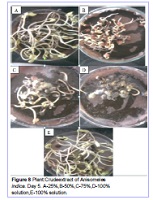To find the efficacy of crude extract from plants on germination of seeds
Keywords:
Germination, seed coat, Quiescent seeds, embryoAbstract
Germination is the growth of an embryonic plant contained within a seed; it results in the formation of the seedling. The seed of a higher plant is a small package produced in a fruit or cone after the union of male and female sex cells. All fully developed seeds contain an embryo and, in most plant species some store of food reserves, wrapped in a seed coat. Some plants produce varying numbers of seeds that lack embryos, these are called empty seeds, and never germinate. Most seeds go through a period of quiescence where there is no active growth; during this time the seed can be safely transported to a new location and/or survive adverse climate conditions until circumstances are favorable for growth. Quiescent seeds are ripe seeds that do not germinate because they are subject to external environmental conditions that prevent the initiation of metabolic processes and cell growth. Under favorable conditions, the seed begins to germinate and the embryonic tissues resume growth. In the present study, research was done to find the effect of crude extract of plants on germination of seeds. The plants which we have chosen may show the positive or negative effect on the germination of seeds. This has some importance in the rain fed areas. Even the specific plant extract soaked and sow in land may helpful to tolerate the drought conditions. Also study is helpful to agriculture or agricultural industry. It helps to find out the anti sprouting property of the plants. However, further work is needed to improve this method.
References
Miller SR. Growth inhibition produced by leaf extracts
from size-controlling apple rootstocks. Canadian
Journal of Plant Science. 1965;45(6):519-24.
Martin PA, Blackburn M. Inhibition of seed
germination by extracts of bitter hawkesbury
watermelon containing cucurbitacin, a feeding stimulant
for corn rootworm (Coleoptera: Chrysomelidae).
Journal of economic entomology. 2003;96(2):441-5.
Koller D, Kozlowski TT. Environmental control of seed
germination. Seed biology. 1972;2.
YONEYAMA K. Search for germination stimulants and
inhibitors for root parasitic weeds. Natural Products for
Pest Management. 2006:88-98.
Saqrane S, Ghazali IE, Oudra B, Bouarab L,
Vasconcelos V. Effects of cyanobacteria producing
microcystins on seed germination and seedling growth
of several agricultural plants. Journal of Environmental
Science and Health Part B. 2008 ;43(5):443-51.
Kakefuda G, Duke SH, Duke SO. Differential light
induction of nitrate reductases in greening and
photobleached soybean seedlings. Plant physiology.
;73(1):56-60.
Gupta N et al. International Journal of
Pharmacy&Technology IJPT. 2011;3(1):1785-1795.
Brown R. Anisomeles, Prodr. 503. 1810. Flora of
China.1994; 17: 188.
Mandial RK. An Insight into the Toxicological and
Medicinal Properties of Lantana camara plant. College
of Veterinary and Animal Science Palampur Himachal
Pradesh. 2006.
Jeyaseelan EC, Pathmanathan MK, Jeyadevan JP.
Inhibitory effect of different solvent extracts of Vitex
negundo L. and Allium sativum L. on phytopathogenic
bacteria. Archives of Applied Science Research.
;2(6):325-31.
Prasad K, Srivastava VC. TELETOXIC EFFECT OF
WEEDS ON GERMINATION AND GROWTH OF
RICE (ORYZA-SATIVA). Indian Journal of
Agricultural Sciences. 1991;61(8):591-2.
Fahey JW. Moringa oleifera: a review of the medical
evidence for its nutritional, therapeutic, and
prophylactic properties. Part 1. Trees for life Journal.
;1(5):1-5.
el-Sheekh MM. Effect of crude seaweed extracts on
seed germination, seedling growth and some metabolic
processes of Vicia faba L. Cytobios. 2000;101(396):23-
Abad MJ, Ansuategui M, Bermejo P. Active antifungal
substances from natural sources. Arkivoc. 2007;7(11):6-
Akan Tunon H, Alkaloids in Achillea millefolium L.
Newyork Botanical Garden SEP – 8 1998.



